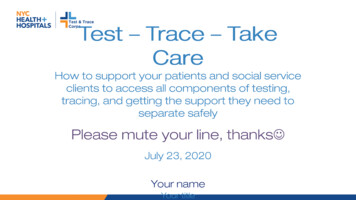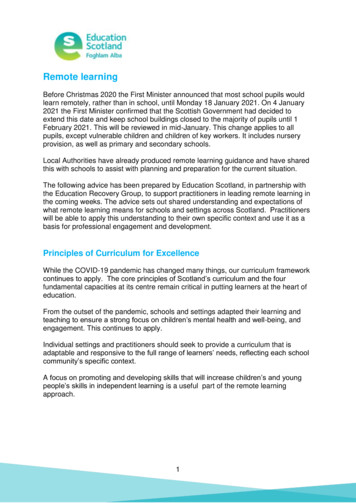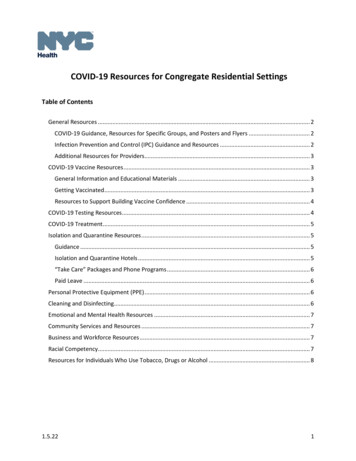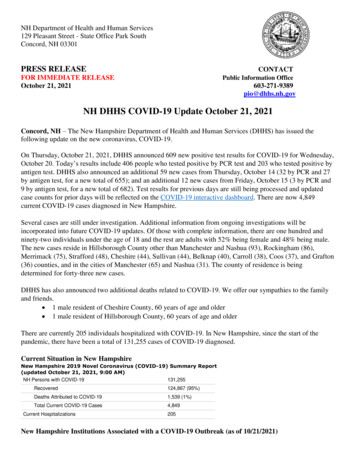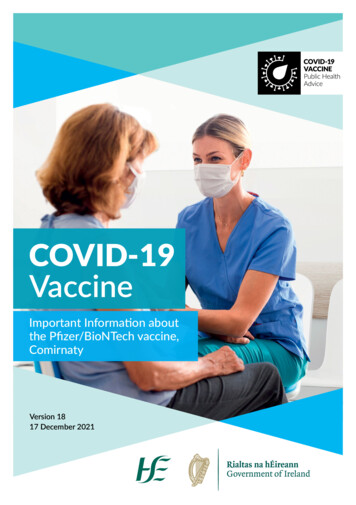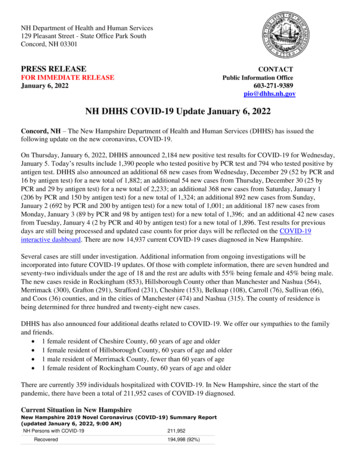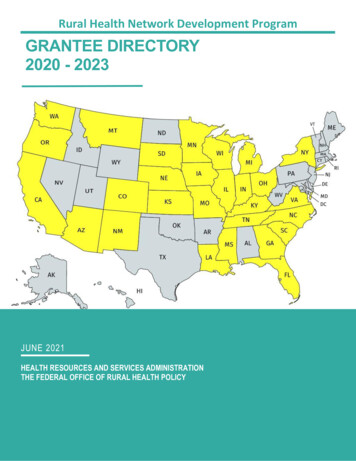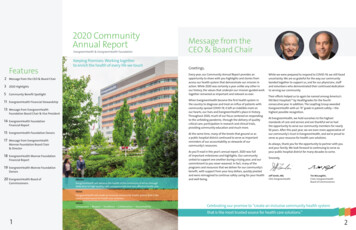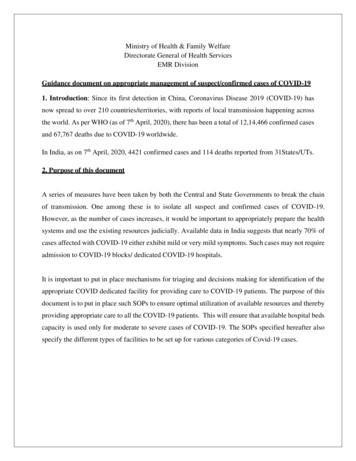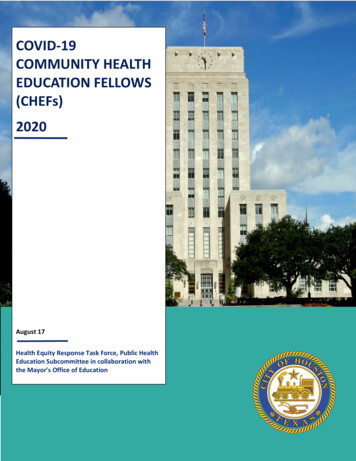
Transcription
COVID-19COMMUNITY HEALTHEDUCATION FELLOWS(CHEFs)2020August 17Health Equity Response Task Force, Public HealthEducation Subcommittee in collaboration withthe Mayor’s Office of Education
Table of ContentsIntroductionExecutive SummaryMethodologyCOVID-19 Community ImpactIncome and Job LossSchool ClosuresLack of Accessibility to InformationFood InsecurityOther Community Needs and ChallengesAddressing Needs by Racial GroupsCommunity SolutionsMeet the First Cohort of CHEFsConclusionAppendix1
AcknowledgementsThe Mayor’s Office of Education is grateful the Health Equity Response (H.E.R.) Taskforce, Public HealthEducation Subcommittee for their support and partnership in developing the Community Health EducationFellowship Program. Their dedication and insights as leaders across the City of Houston contributed to theprogram and the report. A special thanks to the Mayor Sylvester Turner and the Office of the Mayor staff fortheir decisive leadership in the City of Houston’s COVID-19 prevention and response efforts. We also wish toacknowledge Amy Fan and Zoe Parker at the Institute of Engagement who helped us read and code communitydata, also Maria Almaguer, Marlen Benitez, and Laura Cuellar for writing and completing the report, andNorma Torres Mendoza who provided guidance to the execution of the report. Finally, a huge thanks to youngpeople across Houston and the first cohort of CHEFs who contributed their experiences to the report.Members of the H.E.R. Taskforce, Public Health Education Subcommittee:Ø Co-Chair: Dr. Asim Shah MD, Professor and Executive Vice Chair, Psychiatry, Baylor College of Medicine& Chief of Psychiatry Ben Taub HospitalØ Co-Chair: Rosie Valadez McStay MPH, Assistant Vice President Government Relations and CommunityBenefits, Texas Children’s HospitalØ City Lead: Director Juliet Stipeche JD, Director of Education, City of HoustonØ Nelson Bowman, UNICEF USAØ Dr. Tonyel Edwards, Houston EndowmentØ Kimberly Hatter JD, Mayor’s Office, Project Manager for Bloomberg AssociatesØ Dr. Melanie Johnson, Collaborative for ChildrenØ Keila N. Lopez MD MPH, Pediatric Cardiologist, Director of Cardiology Transition Medicine, TexasChildren’s Hospital/Baylor College of MedicineØ Silvia Mintz JD, AttorneyØ Misty Mousa-Lanza, Director, Business Partnerships, Univision Communications Inc.Ø John Puder, Texas Hunger InitiativeØ Janice Weaver, Mayor’s Office, Director of Community RelationsØ Dr. Pam Wells, Executive Director Region IV ESC2
Community Health Fellowship ProgramIn July of 2020, the City of Houston, Mayor’s Office of Education, in partnership with JPMorgan Chase, launched the COVID-19 Community Health Education Fellowship (CHEF) Program. Thefellowship aimed to attract individuals from Houston’s Complete Communities and other areashardest hit by COVID-19 and prepare them to address the urgent need of the COVID-19 pandemic.The program recruited opportunity youth (ages 18-30) who would most benefit from the financialsupport, including stipends, paid training, and paid externship. Like the Tapia-Turner HealthcareScholars Program (TTHS) and Hire Houston Youth Healthcare Scholars initiative, this fellowship ischaracterized by experiential learning, immersion, and a certification process.The Mayor’s Office of Education recognizes the value of accessible and relevant healtheducation in neighborhoods and envision this program will equip young individuals to betterunderstand the needs of vulnerable communities. The CHEF program was designed to empowerstudents to explore public healthcare through a three-week training program and a contact tracercourse in which they would earn community health worker and contact tracer certifications. Aftersuccessfully completing the coursework, CHEFs would participate in a seven-week paid externshipprogram at the City of Houston. This externship would serve as their practicum. Incentives to apply tothe fellowship included a stipend of 500, a COVID 19 Contact Tracer Certification Program, aCommunity Health Worker Certification provided by Houston Community College (HCC), and theopportunity to be hired by the City of Houston through an externship.The CHEFs promote public health education team by delivering valuable information, training,resources, and support to Houston communities. They have served as health liaisons between theCity of Houston and the community by facilitating access to services and improving the quality andcultural competence of delivery. CHEFs have been working at the City of Houston with the Mayor’sHealth Equity Response Task Force and Mayor’s Office of Education. Their roles and responsibilitieshave been varied, and have involved research and analysis, data analytics and reports, supporting theHER Task Force subcommittees, conducting infection prevention and control guidance, supportingcall centers, and developing community health education strategies.CHEFs are frontline public health workers who have a close understanding of the communitythey serve. This trusting relationship enables them to serve as a liaison/link/intermediary betweenhealth/social services and the community to facilitate access to services and improve the quality andcultural competence of service delivery. CHEFs will continue working with communities,neighborhoods, and faith-based institutions to gather information to contribute to tailored publichealth education and wrap-around services that inform through a wide array of communicationalternatives ranging from tele-town halls to social media posts.3
Executive SummaryThe Mayor’s Office of Education (MOE) received 492 applications from young people acrossHouston who wanted to join the first cohort of the Community Health Education Fellows (CHEF)program. The MOE saw and acted upon an opportunity to use the application process to gather a richdata set on the impact COVID-19 had on the CHEF applicants and their families. This report providesdetails on the five major needs faced by underserved communities and racial minorities includingincome loss, food insecurity, school closures, and lack of accessibility to information. The report alsopresents community solutions from the perspective of the city’s young people and introduces thefirst cohort of CHEFs and their experiences thus far.4
MethodologyThe CHEF program applications provided information on applicants which includeddemographics, school and employment data, and impact of the pandemic on the lives of theapplicants. The provided demographic information included the zip codes and council districts whereapplicants resided, their birthdates, ages, race/ethnicities, and the languages that the applicantsspoke. Additionally, completed applications contained school and employment data including thehigh school the applicants attended, if applicants were enrolled in HCC, if they were employed, ifthey were currently taking classes, the certifications that the applicants had obtained, and theirfuture education and career plans. The MOE also collected household data including estimatedhousehold income, the number of individuals in a household, and if participants had a need forchildcare. Finally the applicants were asked to discuss how their communities have been impacted bythe COVID-19 crisis, and what resources were and, in many cases, are still needed in order for theircommunities to confront the COVID-19 crisis.Coding SystemThe MOE interns and fellows created a coding system to analyze qualitative responses and report onthe most pressing community needs experienced by the applicants during the COVID 19 pandemic.After reading the applications the MOE team decided to focus the data analysis on the following twoquestions from the CHEF applications:1. How has your community been impacted by the COVID-19 crisis and closures ofschools, jobs, etc.?2. What support, resources or information does your community need to confront theCOVID-19 crisis?Insight on Community ChallengesThese two questions provided insight on what challenges communities were facing during the COVID19 pandemic and how the MOE can help young people address those challenges. The applicant’sresponses helped the MOE create 19 categories based on the most commonly mentioned issues andchallenges. The categories are listed here in order of most mentioned to least mentioned onapplication responses:1. Job resources/Income insecurity,2. School closures/youthactivities/educational resources forchildren3. Info about COVID (prevention, risks, etc.)4. Food Insecurity5. Personal job or income loss6. Lack of PPE/Hygiene Products7. Business Closures8. COVID-19 Testing9. Mental Health Support10. Child Care Support11. Public Health Advocates12. Lack of community interaction13. Free clinics/healthcare/medicine14. Technology15. Additional Financial Aid for Students16. Housing and Rent Assistance17. Resources for Non-English speakers andUndocumented People18. Increase Crime/Abuse19. COVID-19 deaths5
CalculationsThe MOE interns, along with the help of representatives from the Institute of Engagement,coded and curated the responses from the 492 applications received, into the 19 issue categorieslisted above. To summarize the responses, a "1" was added to the corresponding category every timethe need was stated on an application. They then totaled the amount of 1’s to find the total/492, toget a percentage to see the areas that the CHEFs perceived was lacking in their communities toconfront the COVID-19 crisis and what areas were impacted mostly due to COVID-19.LimitationsThere are some limitations to the data obtained from the CHEF program application. Theapplication was only open to individuals from 18-38 years of age and did not gather data fromindividuals outside of this age range. Moreover, 492 is a small sample size that represents minimalglimpse of the City of Houston residents, which has a population of 2.236 million (2020). The datapresent also comes from individuals seeking a fellowship for professional development or incomeassistance.2
COVID-19 Community ImpactCHEF Applications DatasetIn June of 2020, The CHEF program received 492 applicants from the City of Houston ages of18-38. Approximately 30% of the applicants were from the Complete Communities which includesAcres Homes, Alief, Westwood, Fort Bend Houston,Gulfton, Kashmere Gardens, Magnolia Park, NearNorthside, Second Ward, Sunnyside, and Third Ward.The applicants were selected by different criteriaincluding demographics, interest in public service,strong interpersonal skills, and expertise in the medicalfield and community outreach. The applications alsoserve to gather data on the impact of COVID-19 in theCity of Houston. All applicants were asked to state thechallenges COVID-19 presented to their communitiesand to list the resources needed to confront thepandemic.The CHEF application dataset found five major areas of concern in Houston communities: jobresources and income loss, school activities and resources for children, information about COVID-19,food insecurity, and personal/family job loss. Here, 55% of the 492 cohort applicants noted that jobresources and income loss were an issue in their communities, 51% found that school activities andresources for children were impacted by the pandemic, 50.6% determined that information aboutCOVID-19 was needed in their communities, 24.4% noted increases in food insecurity needs, and 24%were impacted by personal or familial job loss.3
Income and Job LossWhen asked about the impact of COVID-19 in their communities, 24% of applicants reported thatthey or a family member faced income and job loss because of the pandemic, totaling to 119students. More than half of respondents reported a need for income assistance and job opportunitiesin their communities due to COVID-19 closures and decreases in work hours. A student of a family ofsix living in the Northline/Northside area said, “We need financial help, jobs are closed but bills keepcoming, there are still mouths to feed.” An applicant from the El Dorado/Oates Prairie experiencingincome and job loss noted that they were, “. the only person in (their) family with a job.” Theapplicant also stated, “a large sum of my family is benefiting from the food drives nearby but gettingaccess to unemployment benefits was a hassle due to the help lines always being busy.” Othercollege students hoping to participate in summer internships during the spring or summer facedsimilar cancellations, and a Briar Forest college student was unable to complete their academicresearch. An applicant from the Greenspoint area lost their on-campus job after their universitybegan to implement remote classes.School ClosuresSchool closures impacted students from grades K-12 as well as college and university students. As ofJune of 2020, applicants noted that the transition from in-person courses to online classes highlightedthe disparities and challenges students experienced as a result of the pandemic, with 253 (51%) ofapplicants identifying school closures as an important issue, and 36 (7.3%) noting technology as anissue during the pandemic.Applicants stressed the importance of developing activities and strategies to engage students whilealso considering the importance of addressing issues that would prevent access to academicresources. An applicant from Sharpstown shared that they “.shared a laptop with (their) siblings justto do (their) schoolwork.” Another applicant from the Bellfort area expressed their dependence onin-person schooling to receive free access to the internet and “.access to complete homeworkassignments.”Inaccessibility to COVID-19 InformationTo address the barriers communities faced as a result COVID-19, 50.6% of applicants noted that theircommunities lacked adequate and uniform information about COVID and 10.1% of applicantresponses identified health advocacy and representation as areas of need in their communities.Additionally, 4.1% of applicants expressed a need for multilingual access to COVID-19 information formembers of their communities. In their written responses, applicants suggested creating a website orapplication that would help answer questions community members may have. One student fromDistrict C suggested creating a website or application that would serve as an information hub forHoustonians that would “.provide food services, testing, virtual connections should be made readilyavailable to every member of the community.” When describing the needs of Houston communities,applicants also noted the need for multilingual translations, observing that while some informationwas translated to Spanish or French, “.information is not available in other languages like Swahili,Indigenous languages, Nigerian languages, and others.”Food Insecurity4
Food insecurity was the top fourth concern mentioned by the CHEF applicants, with 24% of applicantsstating that people in their community did not have proper access to food due to job loss or workhours being reduced. From the applicants who mentioned food insecurity as a challenge in theircommunity over 50% came from low-income households with an annual income of 50,000 or lowerand 20% came from households with an annual income of 50,000 - 70,000. In addition, AsianAmerican respondents (28%) were more likely than any other racial group to state food insecurity asa community need, followed by African Americans (25%) and Latinx Americans (24%). Whiterespondents were least likely to mention food insecurity as a challenge at 12%.Some applicants shared that their communities were aware of food resources but had troubleaccessing them due to distance, not knowing how to find the resources, or not knowing how to apply.An applicant from Northside/Northline mentioned, “We need financial help, jobs are closed but billskeep coming, there are still mouths to feed. There are places that give out food but not everyoneknows where they are.” Others were aware of food resources in the community but not sure whoexactly needed them for example one applicant from Gulfton (zip code 77081) said, “My ownneighbors were having a hard time buying food for their families, and the saddest part is we wouldn'thave known of their situation if I hadn't visited their house and them being hesitant to offer me food.Thankfully, my father still had his job, so he could buy us food and we were able to help them a little.”Other Community Needs and ChallengesApplicants also mentioned other challenges faced by their community including the need for masksand cleaning supplies (19%), testing sites (16.5%), mental health support (13%), and healthinsurance/free clinics/affordable medicine (8%). One applicant said their community needed accessto more and better personal protective equipment, “important equipment such as masks and gloveswere severely out of stock, many members of my community had to make their own masks or wearother pieces of clothing to cover their faces.” Another applicant shared that communities need morefree testing and said, “I know some people were being denied testing and were told to just selfquarantine however that is an insufficient solution.” Another applicant from South Acres/CrestmontPark mentioned needing closer testing centers for people who may be unable to drive to sites.Childcare for families (8%) was also a stated need and some applicants shared how not havingchildcare impacted families financial stability. One applicant from Acres Home shared, “Many of theresidents of the area I live in have either lost their job or abandoned it to help their kids learn fromhome due to schools closing. They struggle to find someone to look after them when they are awayand many of them are single parents.”Applicants also had concerns regarding business closures (17%), physical isolation (8%), and lack oftechnology (7%) and health information resources for non-English speakers and undocumentedpeople (4%). One applicant called for information in languages like Swahili, Indigenous languages, andNigerian languages and said, “speaking on behalf of my parents, sometimes they will sit and watchthe news and guess what the news is about. From the little knowledge they have, they use it to pickup what they understand.” Another applicant mentioned the need for city officials to speak directlyto undocumented communities and assure them that they can access resources and testingregardless of their legal status. She said, “when we think of economic aid programs, we should try toeliminate as many barriers as possible so folks that are low-income can have access to it. Everyone5
regardless of economic, legal, or housing status should be able to access the resources they need inthe middle of a pandemic.”Other applicants reported the need for additional financial aid for college students (7%), and housingand rent assistance (7%). Some applicants mentioned an increase in crime in their neighborhoods(2%) and having family and community members passed away due to COVID-19 (3%). An applicantfrom Braes Oaks (zip code 77096) mentioned, “many have lost housing and are having to live withother family members. Some families don't or can't attain virus checks for their whole family.”Addressing Needs by Racial GroupsAfrican American applicants stated the main challenges they saw in their neighborhoods andcommunities were job loss and income insecurity (53%) and adapting to school closures (51%). LatinxAmerican respondents stated that job loss and income security (61%) and obtaining informationregarding COVID-19 (57%) were the main challenges in their communities. White applicants statedjob loss and income insecurity (47%) and obtaining information regarding COVID-19 (47%) were topchallenges. The Asian American respondents also listed obtaining information regarding COVID-19(67%) and job loss and income insecurity (57%) as their top two concerns. In addition, somerespondents reported that Asian American communities were subjected to racist verbal abuse andassaults. One of the applicants said, “I’d heard about so many cases on the news, but I was shockedto hear that my friend who works at a Chinese restaurant would receive calls daily telling her ‘yourfood is dirty’ or ‘go back to China’ or ‘stop serving bats.’”Applicants across all racial backgrounds mentioned the need for trusted media sources regardingCOVID-19 and many mentioned there was a lot of misinformation on social media platforms. TheLatinx and Asian American applicants tended to state the need for information more frequently. Inregards, to school closures, a little over half of the minority applicants stated that school closures andthe transition to online classes had a big impact on their learning and activities compared to 29% ofWhite applicants.6
Community SolutionsThe applicants and the community health fellows selected for the first cohort also presentedvaluable solutions on how to address the challenges brought upon the COVID-19 pandemic. Theirapplications provided ideas for community health programs and how to make them more accessibleto underrepresented communities. They also provided suggestions on what information is stillneeded for Houston residents to access social services and stop the spread of COVID-19. They gaveinsights on communication strategies to increase awareness on city resources and COVID-19prevention and provided details on how to craft an effective website. Below are the applicant’s directquotes on proposed community solutions.Services and Programs Mobile Testing Centers: “We need the deployment of mobile testing centers to affectedareas; and programs to help those with underlying health conditions receive theirprescription.”Food Delivery: “The creation of programs for the delivery of free/low-cost, fresh produce tohouseholds in need would mitigate risk of infection while meeting their essential needs.Through these home deliveries, information about the virus and best practices can also betransmitted.”Care Packages for the Elderly: “Elders are at a higher risk of catching COVID-19 so deliveringgoods and medicine to them would be a useful resource. Another resource would be sendingCOVID-19 care packages. The care packages would include Lysol, Clorox wipes, mask,information about COVID-19 and etc.”Tutoring Program for Children: “The importance of staying inside when possible is also hardfor many of the kids in my community that don’t have entertainment at home, which is why Ithink that implementing a tutoring program would be such a good thing to keep the kids safeand busy by having them stay home.Law Enforcement Mask Distribution: “I recently witnessed police handing out tickets to thosein my community that were gathered in groups and not social distancing, but instead ofhaving financial punishment in an already low-income area during a recession why noteducate, distribute masks, and overall teach better practices.”Art for Mental Health: “Finally, programs designed for safe exploration of art and relaxationwould be helpful because stress levels have skyrocketed during this period.”Information Needed On social services: “Accessible communication of information such as the locations of testingsites, the number of confirmed cases in the zip code, businesses in the area that are stillhiring, classes that teach people the importance of community building and communityhealth, access to computers so that people can apply virtually to jobs, workshops on how toapply for rent relief or housing assistance, workshops on how to apply for food assistance andwhere to find food assistance is necessary.”7
Managing COVID-19 Infection: “I think the community needs to be equipped with theknowledge of what to do when they or someone in their family is infected and how to care forthe sick while protecting themselves at the same time.”Immigrant Rights to Healthcare: “The immigrant people have also been affected in mycommunity by the COVID-19 crisis because they are afraid they might have the virus and areafraid they may not get the help they need and be deported instead.”Covid-19 Cases: The areas around town could benefit from up to date numbers on the spreadof the virus. Are the numbers increasing in the area? If so, then the surroundingneighborhoods should be informed and instructed on what precautions they can take to stopthe spread.Free Covid-19 Testing: “Not everyone in my community is insured or knows that COVID-19testing can be free, and I see this as a huge problem. I believe the resources like these thatalready exist for the COVID-19 crisis need to be advertised more in general so no one gets leftbehind for any reason.”Internet Resources: “My community would benefit from awareness that there are companiesthat are donating wireless connection devices to help those that need access to the internet.This would be extremely beneficial if courses are declared to remain in online instruction forthe fall semester.”Communication Strategies Need for Health Advocates: Many applicant responses (10%) stated it is important to havetrained community health workers to disperse health related messages and education indifferent languages. One applicant mentioned residents would be more comfortable receivinginformation about COVID-19 from someone from their own community. She said, “people willbe more likely to no not only accept the severity of the situation but also become moreproactive against it. They will be more inclined to follow the proper health measures thatshould be taken and in turn better the current situation.” Another applicant mentioned havingtrained community health workers could help “disperse health related messages andeducation in different languages.”Multilingual News Broadcasts: “The city must make arrangements with news outlets fromHouston (of all languages) to broadcast weekly updates on locations for testing, safetypractices, and updates on the rates of infection.”COVID-19 Mailings: “Sending newsletters containing information regarding testing sites,unemployment, and other things relevant during this time should be distributed via mail. Thiswould heavily decrease the information disparity between households with internet accessand those without it.”Door to Door Flyers: “I think a door to door flyer with the essential information would behelpful such as testing sites and their hours (and which ones are free) and a phone numberthey can call for help or to answer questions.”Social Media Neighborhood Pages: “The public could be informed by using social media suchas the NextDoor App, Facebook, Instagram etc. If we had the links to the area civic club pagesor had access to the specific neighborhood pages on social media posts could also be madethere.”8
COVID-19 Website Current COVID-19 Cases Information: “I believe an important resource for my community tosuccessfully confront COVID-19 is accurate, real-time information It is very important thateven with reopening, people are aware of the status of COVID in their communities. This canbe done through a website or app that tracks positive cases in different communities sopeople can assess the threat level for themselves. The media has tendencies to exaggerateand present biased information, so it is necessary to have resources that are fact-based andaccurate.”Community Resources: “Handling the pandemic requires the community to have access toknowledge on where to seek assistance. Websites that provide food services, testing, virtualconnections should be made readily available to every member of the community. Virtualgatherings online among members of the community are also imperative in finding jobopportunities for those experiencing layoffs due to the pandemic.”Clarity regarding COVID-19 Prevention: “Many people are still unsure about what we shouldbe doing concerning COVID-19 and are not wearing protective equipment and do notcomprehend why it is important. There is a mixed response from different sources on whatprecautions should be carried out. Some people are choosing to not carry out any precautionsat all. While in some areas people still struggle to find equipment with ongoing shortages ofdisinfectant and sanitation supplies.”9
Meet the First Cohort of CHEFsThe first cohort of CHEFs was composed of 19 individuals from diverse racial backgrounds,seven of which are from the Complete Communities including Acres Homes, Alief, Gulfton, Sunnyside,and Third Ward. Others were from Super Neighborhoods with high numbers of COVID-19 cases. TheCHEFs came from different racial backgrounds, and 10 of them spoke various languages includingPunjabi, Hindi, Moghamo, Swahili, Spanish, and Portuguese. The program targeted youth ages 18-30and 16 of the CHEFs were under the age of 24 (Appendix A and B provides more CHEF participantdetails and demographics). As part of the fellowship, the CHEFs joined workstreams where they arehelping to adapt and implement the CHEF curriculum, design the Health Equity Response (H.E.R)Taskforce Microsite, and assist with the logistics of the program. Below learn more about the CHEFsand the projects they have been working on.Curriculum WorkstreamThe CHEFs reviewed the curriculum prepared by the University of Texas and provided suggestions onformat, accessibility, and of the curriculum. The format suggestions included having more visual aidsand graphics and providing multilingual translations of the curriculum. The curriculum also shouldinclude maps of testing centers and resources for Houston’s communities. Accessibility of thecurriculum was an important focus area for the CHEFs. They suggested adding a section for people withdisabilities and lowering the reading level to make the information adaptable for communities thatmay use their children as language brokers. Finally, the CHEFs believed it was essential to includeadditional support for underrepresented communities who need mental health, food, and housingresources and personal protective equipment (PPE).The additions needed in the curriculum included more
Acres Homes, Alief, Westwood, Fort Bend Houston, Gulfton, Kashmere Gardens, Magnolia Park, Near Northside, Second Ward, Sunnyside, and Third Ward. The applicants were selected by different criteria including demographics, interest in public service, strong interpersonal skills, and expertise in the medical field and community outreach.

